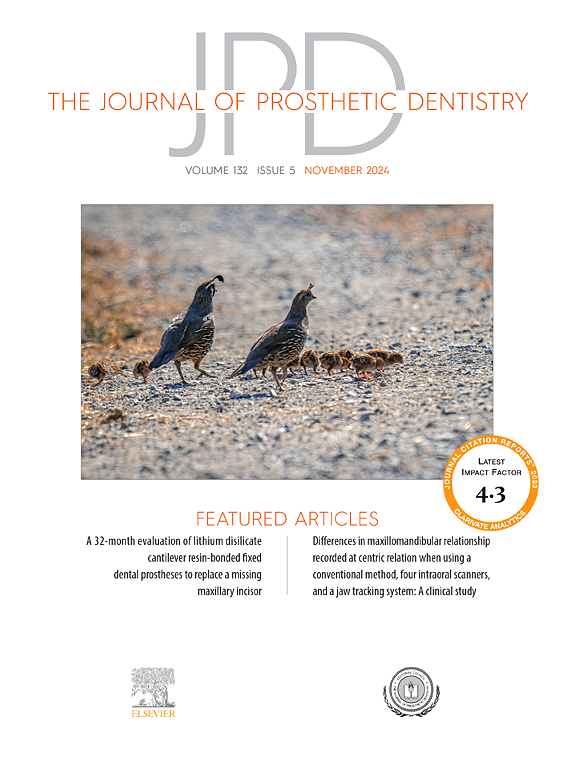A completely digital workflow for PEEK removable partial dentures: A preliminary clinical study
IF 4.8
2区 医学
Q1 DENTISTRY, ORAL SURGERY & MEDICINE
引用次数: 0
Abstract
Statement of problem
The full-process digital polyetheretherketone (PEEK) removable partial denture (RPD) has the potential to significantly improve patient treatment comfort and work efficiency. However, a comparison of the fit, mastication efficiency, clinical efficacy, and patient satisfaction between completely digital and semidigital workflows for PEEK RPDs is needed to assess its benefits.
Purpose
The purpose of this preliminary clinical study was to compare the differences in the fit, mastication efficiency, clinical efficacy, and patient satisfaction between completely digital and semidigital workflows for PEEK RPDs.
Material and methods
Twenty participants with partial edentulism were included in the study. Each received two types of RPD, one fabricated using a completely digital workflow and the other using a semidigital workflow. The completely digital group used intraoral scanning with a 3Shape scanner to obtain digital scans, followed by computer-aided design and computer-aided manufacturing (CAD-CAM) of the dentures. The semidigital group involved traditional polyvinyl siloxane (PVS) impressions, gypsum casts, and the subsequent CAD-CAM processing of the dentures. PVS was used to replicate the gap between the oral mucosa and the RPD baseplate tissue in both groups, and 3-dimensional (3D) deviation analysis was used for measurements. Mastication efficiency was measured using the absorbance method, and patient satisfaction was evaluated via a questionnaire. T tests were conducted to compare the fit, mastication efficiency, clinical efficacy, and patient satisfaction between the two groups (α=.05).
Results
A significant difference in the fit was found between the baseplate tissue and oral mucosa at the distal extension of the RPD between the completely digital and semidigital PEEK RPDs (P=.038, P=.023), while no significant difference was observed at the nondistal extension end (P=.445, P=.331). No significant difference in mastication efficiency was found between the two groups (P=.448). The completely digital group reported higher comfort levels than the semidigital group (P<.001). No significant differences in overall denture satisfaction were found between the two groups at 1, 2, and 3 months after restoration (P=.730, P=.463, P=.526).
Conclusions
Both completely digital and semidigital workflows for PEEK RPDs achieve good fit. The completely digital PEEK RPD significantly enhances patient comfort and work efficiency, making it a suitable option for broader application.
PEEK可摘局部义齿的全数字化工作流程:初步临床研究。
问题说明:全流程数字化聚醚醚酮(PEEK)可摘局部义齿(RPD)具有显著提高患者治疗舒适度和工作效率的潜力。然而,需要对完全数字化和半数字化的PEEK rpd工作流程的配合度、咀嚼效率、临床疗效和患者满意度进行比较,以评估其益处。目的:本初步临床研究的目的是比较完全数字化和半数字化工作流程在PEEK rpd的配合度、咀嚼效率、临床疗效和患者满意度方面的差异。材料与方法:选取20例局部全牙患者作为研究对象。每个人都收到两种类型的RPD,一种使用完全数字化的工作流程,另一种使用半数字化的工作流程。全数字化组使用3Shape扫描仪进行口内扫描,获得数字扫描结果,然后进行义齿的计算机辅助设计和计算机辅助制造(CAD-CAM)。半数字组包括传统的聚乙烯醇硅氧烷(PVS)印模,石膏铸造,以及随后的CAD-CAM处理假牙。采用PVS复制两组口腔黏膜与RPD基板组织之间的间隙,并采用三维(3D)偏差分析测量。采用吸光度法测量咀嚼效率,并通过问卷调查评估患者满意度。采用T检验比较两组患者的配合度、咀嚼效率、临床疗效和患者满意度(α= 0.05)。结果:在全数字和半数字PEEK RPD的远端延伸处,基板组织和口腔黏膜的配合度有显著差异(P=。038, P=.023),而非远端伸展端无显著差异(P=。445年,P = .331)。两组咀嚼效率差异无统计学意义(P=.448)。完全数字化组报告的舒适度高于半数字化组(结论:PEEK rpd的完全数字化和半数字化工作流程都达到了很好的契合度。完全数字化的PEEK RPD显着提高了患者的舒适度和工作效率,使其成为更广泛应用的合适选择。
本文章由计算机程序翻译,如有差异,请以英文原文为准。
求助全文
约1分钟内获得全文
求助全文
来源期刊

Journal of Prosthetic Dentistry
医学-牙科与口腔外科
CiteScore
7.00
自引率
13.00%
发文量
599
审稿时长
69 days
期刊介绍:
The Journal of Prosthetic Dentistry is the leading professional journal devoted exclusively to prosthetic and restorative dentistry. The Journal is the official publication for 24 leading U.S. international prosthodontic organizations. The monthly publication features timely, original peer-reviewed articles on the newest techniques, dental materials, and research findings. The Journal serves prosthodontists and dentists in advanced practice, and features color photos that illustrate many step-by-step procedures. The Journal of Prosthetic Dentistry is included in Index Medicus and CINAHL.
 求助内容:
求助内容: 应助结果提醒方式:
应助结果提醒方式:


